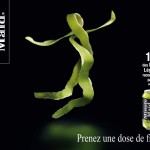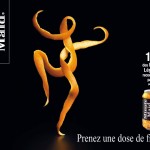Body agnosia, autism and Exposure Anxiety
 Continuing my discussions with French psychologist, Dr Luc-Laurent Salvador, here’s our discussion about body agnosia, autism and Exposure Anxiety:
Continuing my discussions with French psychologist, Dr Luc-Laurent Salvador, here’s our discussion about body agnosia, autism and Exposure Anxiety:
DR LUC-LAURENT
The advertisement picture I would like to show you is not a production of mine. It belongs to an intriguing series of pictures of the Minute Maid company and I would like to know if you already stumbled upon them and how they appeared to you ? Where they self-evident or did you have to somehow guess about their meaning ?
This is the first sample…

DONNA WILIAMS:
I see a peel and some fruits but the peel has been made into a dancer. I can see this because I’m an artist.
DR LUC-LAURENT
How interesting ! You saw the dancer. I was wondering if you could. I would have suggested that most autists could not. It seems that you succeeded pretty well in building an efficient scheme of the human body.Because, in my opinion, it’s far from obvious to spot it in the picture. You say that you can see this because you are an artist:
* Do you mean that, because you are an artist you had the opportunity to develop special competences regarding the perception of the human body ?
DONNA WILIAMS:
Because I’m a sculptor and spent late childhood putting small statues in my mouth and putting my body into the forms of sculptures at the cemetery. Plus age 4-8 I was a dancer and my body put into dance forms and made to hold those forms for anything up to 20 min. And being face blind, I stopped tuning to colour and clothes and items and by mid-late childhood tuned to movement… I see movement.
DR LUC-LAURENT
Would say that weren’t be the case, you would have had difficulties in perceiving correctly the picture ?
DONNA WILIAMS:
I can’t know what else I’d be if…
DR LUC-LAURENT
Would you agree that most autists, and maybe yourself before you became an artist, would probably remain blind to the human body in this picture ?
DONNA WILIAMS:
No, look at the work of autistic artist Christophe Pillault
DR LUC-LAURENT
When asking “what if you didn’t develop competences regarding the perception of human movements and body?”, I had in mind what you labeled as “body agnosia“. I didn’t ask for details, but as you told me that you had a visual fragmented perception, I inferred that, of course you couldn’t perceive a body as whole. At best, you were able to recognize some body parts, weren’t you?
DONNA WILLIAMS
Yes. It’s just that I saw each bit unconnected to the next… I think some of this was that I didn’t visually ‘track’ I would ‘spot’ and that spotting would be fairly random so ‘human’ might be hair+earring+shoe+hand and then another time ‘human’ might be bag strap+mouth+eyebrow+collar+keys… so the concept of ‘human’ ends up being far more problematic visually than say ‘cat’ which is ear+tail+fur or another time movement+black+purr+nose but without the confusion of clothing or accessories.
DR LUC-LAURENT
If my memory is correct, whole body perception first occurred in the mirror with “her”, isn’t it? My hypothesis is that this state of “congenital full body agnosia” is the very root of autism. And if nothing special happens, this agnosia will remain and therefore considerably hinder the possibility of relating to any “other”.
DONNA WILLIAMS
I’d agree with that. I am so face blind I’ve confused my husband for the neighbor, been unable to recognise the neighbor when around the corner at the shops, even had someone move from opposite to at the side and not known its the same person, but I’d still say that I’m not as face blind as a kid because at least now I recognise my reflection and can see faces and bodies as a whole (since diet, tinted lenses, treatment for gut/immune/metabolic disorders) but some of the visual cohesion improvement came from training my vision to borrow from kinesthetic and auditory learning… so I can look at most things and know how they feel to touch and the sound they’d make if tapped and how they’d move if flicked… that that all helped train general object recognition to the point I’m only now context blind, not object blind, but some of that extended to humans… that since close physical contact with humans (for good and bad), especially I’ve felt faces, bodies like a sculptor would. And that makes my mind LOOK for the cohesion or perhaps imagine it. I hope that makes some sense.
DR LUC-LAURENT
Concerning the peel pictures, my guess is that a person in such a state of congenital full body agnosia can’t see a human body in it.
DONNA WILLIAMS
I would agree, that I developed the ability to see art in objects as part of agnosia but to see humans in objects developed around my 20s as I remember photographing taps and doorbells and left over food which resembled human faces and movements. I began painting cats in my 20s but by my 30s became a figurative artist and sculptor. Some people find that odd, but if you look at my art most of my people have no faces and the paintings have little visual context and the emphasis is on movement. And I don’t think it’s odd that someone who struggled with gaining functional speech chose to study linguistics, someone who struggled to perceive themselves in the same world as others studied sociology or that someone who struggled with human form became a figurative artist. It shows my personality though, that I like to conquer mountains.
DR LUC-LAURENT
As far as I understand, you escaped this thanks to your incredible efforts for body mastery through “other mirroring” (echopraxia, imitation, sculpture modeling, dance) and “self-mirroring” (with “her”). The more you developed an efficient human body scheme, the more you entered the so-called “social mirror” realm where the (Cooley’s looking-glass) Self builds. And the more you were coming to the presence of others, the more you were concerned by Exposure Anxiety .
DONNA WILLIAMS
Yes, that is certainly true… that as one ‘wakes up’ one feels TOO DAMNED HERE. It’s a sort of neuro-emotional immaturity… how can you start to trust social audience/invasion when you are still getting into and familiar with your own body, not yet able to hold onto self and other enough to get comparison of one’s own versus theirs etc and who is doing what and how its all connected up… of course it triggers the involuntary avoidance, diversion, retaliation response of Exposure Anxiety.
Self in relation to other is a whole other thing. When one is a mono processer one processes all self/no other, all other/no self because each new chunk budges out the other… same with vision, that it is an achievement to process the hand in relation to the arm etc… or with the auditory, to be able to process intonation AND the word simultaneously without one canceling out the simultaneous perception/processing of the other.
Inability to hold self and other at the same time becomes a big impairment. as one finds constantly that interaction means either failing by being ‘in front’ of or ‘at’ but not ‘with’ or that the ‘with’ of others results in the self going offline or reducing to an information gathering machine (mind without self)
DR LUC-LAURENT
“I understand that.
It looks like a “winner-take-all†process.
When there’s no other, consciousness may freely enjoy or indulge in self-consciousness.
But when an other is present, the whole mental energy seems consumed by the attempt to elaborate and maintain an acute mental model of this other.
Particularly for what concerns her/his way of judging the self (cf. the social mirror metaphor)
When perception is not based on a configuration (a shape or a “whole†if you will) from the very beginning it’s very difficult to built it later because one has to deconstruct the previous acquisitions based on part perception. As I understand it, it’s the reason why you are face blind. You had no human face anticipation available at first and it is now very difficult for you to see it as a whole (of course, bimodal (visual+tactile) perception can help, but it’s no solution for everyday life). That’s why autists are much better at recognizing inverted (upside down) faces. Because loosing the natural configuration of face is no problem for them : they don’t have it in the first place.
What do you think of that ?
DONNA WILLIAMS
I very much agree with this:
When perception is not based on a configuration (a shape or a “whole†if you will) from the very beginning it’s very difficult to built it later because one has to deconstruct the previous acquisitions based on part perception.
Because I still experience a shift where within a minute my mind has shifted back to meaning blindness and the world is again ART, and visuals are joined musically (its a cross over where musical thinking helped to pull visuals together, same as where musical thinking helped me learn to segment speech so I could hear the breaks between words, before which it was receptively tumbling). Anyway, this deconstruction aspect happens on the visual-verbal processing system too because, for example, let’s say I see a telegraph pole as ‘cement tree’ then when someone says ‘telegraph pole’, I have to go back through ‘cement tree’ to translate. And expressively happens similarly, so even though I progressed from echolalia around age 9-11, I’ll go to speak sometimes and I’m thinking in stored phrases (pattern, theme, feel) and I have to stop that speech on the way out, translate it into the one-word-one-meaning semantic system and project it at the other person. So I definitely experience the old systems and new competing.


An interesting conversation/interview. I never thought of body agnosia in quite those terms. I’m familiar with the concept, but wasn’t familiar with the word. I always thought it had more to do with proprioception than visual perception.